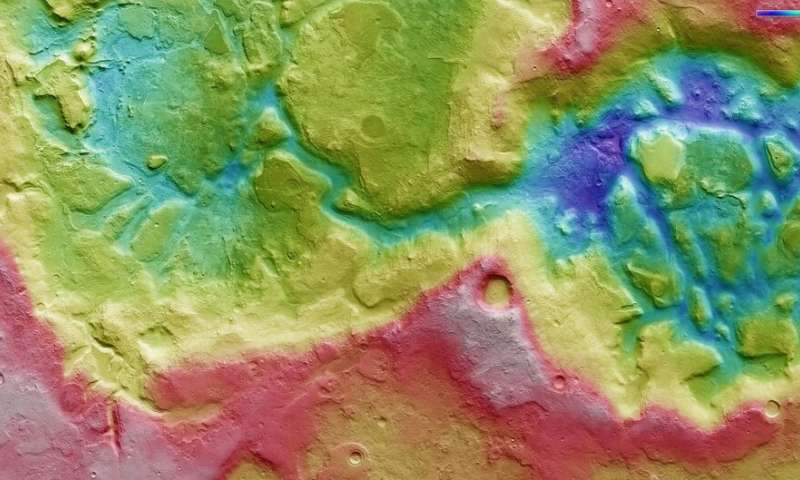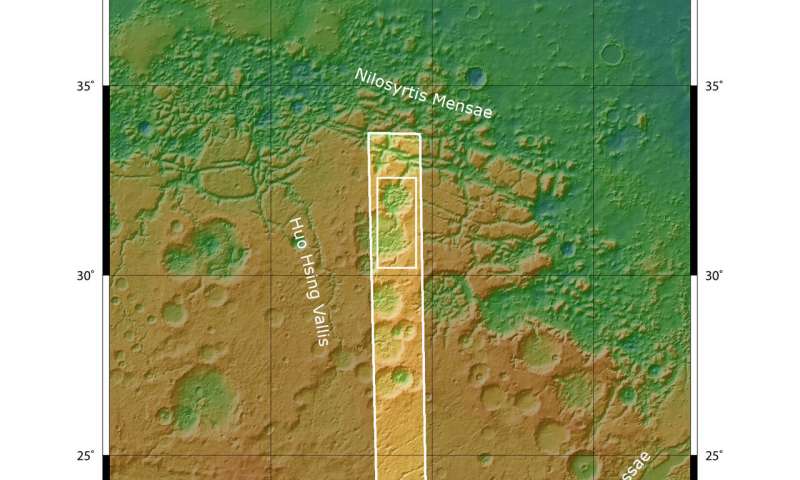Images: The two halves of Mars' whole
Mars is very much a world of two halves – as highlighted by this new image from ESA’s Mars Express, which shows where the planet’s dramatically different hemispheres come together as one. The northern hemisphere of Mars is flat, smooth and, in places, sits a few kilometres lower than the southern. The southern hemisphere, meanwhile, is heavily cratered, and peppered with pockets of past volcanic activity. A transition zone known as ‘dichotomy boundary’ separates the northern lowlands and southern highlands. Large parts of this region are filled with something scientists call fretted terrain: blocky, broken-up, fragmented swathes of terrain where the rough, pockmarked martian south gives way to the smoother north. This image shows a region of fretted terrain named Nilosyrtis Mensae; channels, valleys and worn-away craters can be seen across the frame, reflecting the water, wind and ice erosion the region has experienced over martian history. This image comprises data gathered on 29 September 2019 during orbit 19908. The ground resolution is approximately 15 m/pixel and the images are centred at about 69°E/31°N. This image was created using data from the nadir and colour channels of the High Resolution Stereo Camera (HRSC). The nadir channel is aligned perpendicular to the surface of Mars, as if looking straight down at the surface. North is to the right. Credit: ESA/DLR/FU Berlin
Mars is very much a world of two halves, as this new image from ESA's Mars Express highlights, showing where these dramatically different regions come together as one.
The morphology and characteristics of the martian surface differ significantly depending on location. The northern hemisphere of Mars is flat, smooth and, in places, sits a few kilometers lower than the southern. The southern hemisphere, meanwhile, is heavily cratered, and peppered with pockets of past volcanic activity.
A transition zone known as 'dichotomy boundary' separates the northern lowlands and southern highlands. Large parts of this region are filled with something scientists call fretted terrain: blocky, broken-up, fragmented swathes of terrain where the rough, pockmarked martian south gives way to the smoother north.
This new image from the Mars Express High Resolution Stereo Camera (HRSC) shows exactly that: a region of fretted terrain named Nilosyrtis Mensae.
Nilosyrtis Mensae has a labyrinthian appearance, with numerous channels and valleys carving through the terrain. Water, wind and ice been strongly affecting this region, dissecting and eroding the terrain, along with changes in martian geology: valleys have formed over time and sliced across the region, and once-defined impact craters have slowly degraded, their walls and features gradually wearing away.
This colour-coded topographic image shows a region of Mars’ surface named Nilosyrtis Mensae, based on data gathered by the Mars Express High Resolution Stereo Camera on 29 September 2019 during orbit 19908. This view is based on a digital terrain model (DTM) of the region, from which the topography of the landscape can be derived; lower parts of the surface are shown in blues and purples, while higher altitude regions show up in whites, yellows and reds, as indicated on the scale to the bottom left. North is to the right. Credit: ESA/DLR/FU Berlin, CC BY-SA 3.0 IGO

The large crater to the right of the frame is an example of this degradation: it has a smooth, rounded appearance, with gently sloping walls, softened edges, and a flat bottom that has been widened and filled by sedimentary material over time. This worn-away morphology reflects both the crater's advanced age, and the levels of erosion it has undergone since it formed.
Such erosion processes also created rounded hills and isolated flat-topped hills, or 'mesas," that are visible within the crater and across the region more widely. These stand apart from their surroundings as isolated features, and contribute to the blocky, fractured appearance of fretted terrain.
Scientists are interested in Nilosyrtis Mensae not only for its location in this intriguing transition zone between north and south, but also for the secrets it could hold about the history of water on Mars.
This image shows a region of Mars’ surface named Nilosyrtis Mensae. It comprises data gathered on 29 September 2019 during orbit 19908. The ground resolution is approximately 15 m/pixel and the images are centred at about 69°E/31°N. This image was created using data from the nadir and colour channels of the High Resolution Stereo Camera (HRSC). The nadir channel is aligned perpendicular to the surface of Mars, as if looking straight down at the surface. This perspective looks over the region from north to south. Credit: ESA/DLR/FU Berlin, CC BY-SA 3.0 IGO
This image shows shows a region of Mars’ surface named Nilosyrtis Mensae in wider context. The area outlined by the bold white box indicates the area imaged by the Mars Express High Resolution Stereo Camera on 29 September 2019 during orbit 19908. Credit: NASA MGS MOLA Science Team
Observations of this region by missions such as Mars Express have revealed ridges, grooves and other surface textures indicative of flowing material—most likely ice.
The climate and atmosphere of ancient Mars allowed ice and snow to accumulate and move around across the planet's surface.
Ice is thought to have flowed through the various valleys and across the plateaus in this region, in the form of slow-moving glaciers that swept up debris as they traveled. Such features would be similar to rock glaciers here on Earth: either icy flows covered in layers of mud and sediment, or flowing mixtures of ice, mud, snow and rock interspersed with larger rocks and boulders.
Studying and characterizing the various processes at play across the surface of Mars is a key aim of Mars Express. Launched in 2003, the spacecraft has now been orbiting the Red Planet for over a decade and a half. Meanwhile, the ESA-Roscosmos ExoMars Trace Gas Orbiter (TGO) joined in 2016, soon to be joined by the ExoMars Rosalind Franklin rover and its accompanying surface science platform, scheduled for launch in July.



No comments:
Post a Comment